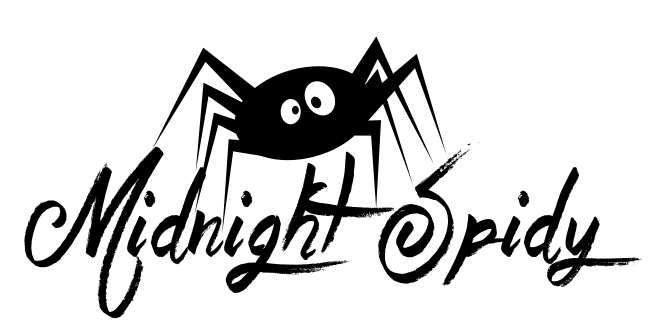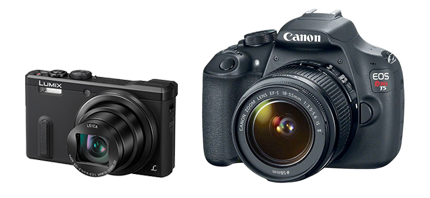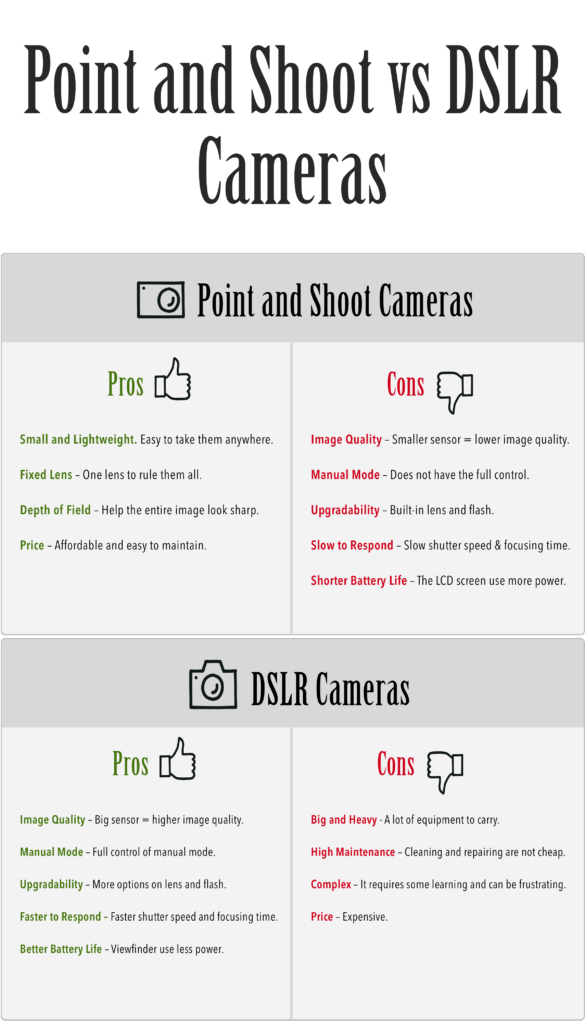Point and Shoot or DSLR camera?
As a beginner entering the World of photography, picking your camera can be both scary and intimidating. Eventually, you will have to decide which type of camera, Point and Shoot or DSLR, would be your first to invest in. Most modern Point and Shoot cameras are very good and affordable. The DSLR cameras are a no brainer, but they are not cheap. I think, in order to make the right decision, you must know the differences between these two types of cameras. I personally own both Point and Shoot and DSLR cameras. I use them in a different situations.
So what camera should you get, Point and Shoot or DSLR camera? Let’s find out together!
Point and Shoot Cameras (P&S)
Point and Shoot cameras does exactly what it says. You point and you shoot! Most P&S cameras have a fixed lens, it means that the lenses are attached to the body of the camera. Most modern P&S cameras nowadays do not have a viewfinder built-in so you will have to look through its LCD screen. P&S cameras do not give you many options for manual control. The smaller size sensor is no match to the DSLR cameras.
DSLR Cameras
A DSLR (Digital Single-Lens Reflex) camera’s body has a mirror that reflects the light coming through the lens. It sends the picture through a prism or a series of mirrors, then off to the optical viewfinder. Once the shutter is pressed, the mirror flips up and reflexes the light directly to the sensor. The DSLR cameras also give you the full control in manual mode.
So what’s the main difference?
Point and Shoot or DSLR camera? You’ve probably heard the term, “What you see is what you get.” The DSLR cameras allow you to see the picture in real-time. The Point and Shoot cameras tend to generate delay because the sensor has to transfer the picture to its digital display instead of the viewfinder.
Point and Shoot Cameras – Pros & Cons
PROS
Weight & Size – Small and lightweight. Easy to take them anywhere.
Fixed Lens – One lens to rule them all. No need to change lenses. The built-in lens can do everything from wide angle, zoom, and macro.
Depth of Field – The Point and Shoot cameras tend to bring both the foreground and background to focus which help the entire image look sharp. This could both be good for the landscape and bad for a portrait.
Price – More affordable and easier to maintain.
CONS
Image Quality – The Point and Shoots have smaller size sensor. Even with more Megapixels, the image quality will always be lower than the DSLR cameras.
Manual Mode – Although most Point and Shoot cameras come with Aperture and Shutter Priority mode, it is still difficult to manually set ISO, shutter speed, and aperture separately.
Upgradability – Most Point and Shoot cameras are not adaptable. Their lens and flash come built-in and cannot be changed (with the exception of some high-end models.)
Slow Shutter Speed and Focus – Since the Point and Shoot cameras are relying entirely on digital display. They are known for slow shutter speed and focusing time.
Shorter Battery Life – The LCD screen usees more power to display information.
DSLR Cameras – Pros & Cons
PROS
Image Quality – Having a big sensor helps decrease noise and increase overall image quality.
Manual Mode – DSLR is generally designed for photographers who want to have the full control of their own settings. The other extra modes, such as auto and scenery, are considered to be bonuses.
Upgradability – The ability to change lenses and flashes opens up possibilities to explore and achieve better image quality. It directly impacts the lens and flashes you use.
Faster Shutter Speed and Focus – The advantage of the good old single lens-reflex is no shutter lagging or slow focusing.
Better Battery Life – In general, the optical viewfinder uses less power.
CONS
Weight & Size – DSLRs are quite heavy. The become even heavier when you add a lens or two to your camera bag.
Maintenance – Every time you change lenses, you risk introducing dust on your camera. The cost for sensor cleaning is not cheap since it needs to be done professionally. Some newer models come with self-cleaning sensors.
Complexity – The DSLR cameras are somewhat complicated. They require some learning and can be frustrated in the beginning.
Price – Price is probably the main factor for most beginners. Even an entry-level DSLR will most likely cost more than an advanced Point and Shootcamera. Then there is the cost of the extra accessories such as lens, filters, flashes, and so on.
* Please note! These are not the full list of the PROS and CONS. You can probably find more information online or by experiencing it yourself.
What should you get as your first camera?
So Point and Shoot or DSLR? This is when I turn the question back to you. You will need to find out for yourself. Depending on your budget, usage, and situation, the scenarios below may help you make the right decision.
You should consider getting a Point and Shoot camera, if…
– you travel a lot and want something thats easy to take with you.
– you take general and landscape photos most of the time.
– you have a small budget and really want to get into photography.
– you don’t care much about the image size or print.
You should consider getting a DSLR camera, if…
– you don’t have a budget issue.
– you take both portrait and low-light landscape photo.
– you take lots of action shots such as sports, activities, and motions.
– you don’t mind carrying your camera kit bags with you.
Personally, I would recommend having both. I own a few Panasonic Lumix ZS series because they are thin, compact, and have very nice lens. I have many great shots with these Panasonics. I can not tell you how many times I grab my Point and Shoot camera and run because of an opportunity. If I have time to plan ahead, most likely I will grab both my DSLR and P&S.
If you are concerned about the depth of field on the Point and Shoot, there are a few tricks that I used to achieve that bokeh look (shallow depth of field or blurry background.) I might write about this in the near future.)
Here are samples of photos I took with my Point and Shoot Panasonic DMC-ZS40 vs my entry-level Canon EOS Rebel T5.
At the end, whichever you ended up choosing, please remember to have fun, explore, and learn as many new skills as you go. You are the one telling your story. You are the one who captures the memories. You decide how the story is told.
Until next time, happy shooting! 🙂
Read my previous posts at www.midnightspidy.com












